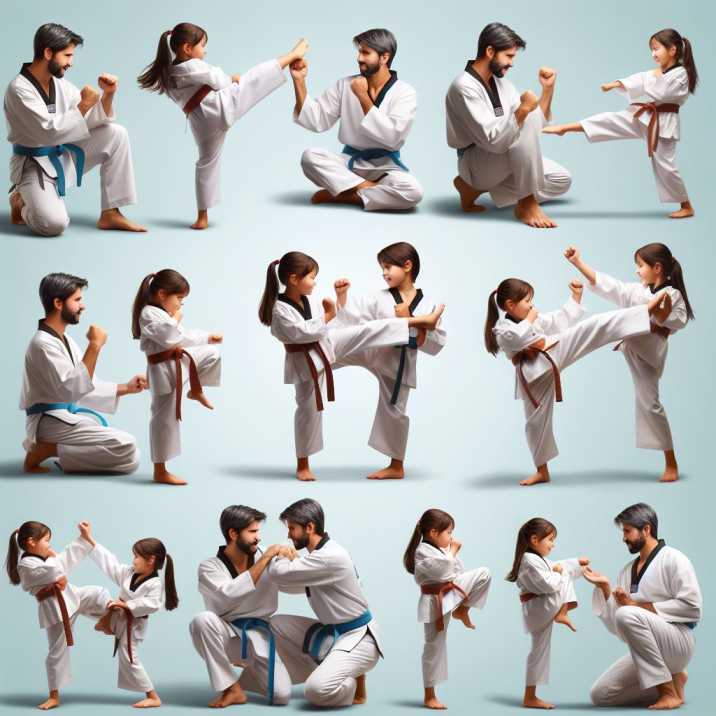Introduction
Table of Contents
Taekwondo stances serve as the foundation of this ancient martial art, blending grace, power, and precision into every movement. Whether you’re a beginner or an experienced practitioner, understanding and mastering these stances is crucial for advancing in Taekwondo. In this comprehensive guide, we’ll delve into the intricacies of Taekwondo stances, exploring fundamental techniques, advanced strategies, and everything in between.
The Fundamentals of Taekwondo Stances
Basics of Taekwondo Stances
Mastering the basics is essential in any martial art, and Taekwondo is no exception. The fundamental stances in Taekwondo provide the building blocks for more complex techniques. Let’s explore these key stances:
Attention Stance (Charyeot):
This is the starting position in Taekwondo, emphasizing respect and discipline. Feet are together, arms are by the sides, and eyes are focused straight ahead.
Parallel Stance (Narani Seogi):
In this stance, the feet are shoulder-width apart, and the body weight is evenly distributed between both legs. It’s a versatile stance used for various techniques.
Walking Stance (Gunun Seogi):
Also known as the “natural stance,” this position is used for basic movements and transitions. One foot is placed in front of the other, with the majority of the body weight on the back leg.
Front Stance (Ap Seogi):
This stance emphasizes stability and power, with one foot positioned in front of the other, creating a longer and narrower stance.
Back Stance (Dwitbal Seogi):
Similar to the front stance, but with the opposite foot positioned in front. It’s often used for defensive techniques and evasive maneuvers.

Advanced Techniques and Strategies
Advanced Taekwondo Stance Techniques
Once you’ve mastered the fundamentals, it’s time to explore advanced techniques and strategies that leverage Taekwondo stances for maximum effectiveness. Here are some key aspects to consider:
Dynamic Balance:
Advanced practitioners focus on maintaining dynamic balance while executing techniques from various stances. This involves shifting weight smoothly between different parts of the body to maintain stability and control.
Speed and Agility:
Taekwondo emphasizes speed and agility, and advanced stances incorporate dynamic footwork and quick transitions between stances to outmaneuver opponents.
Precision and Control:
Advanced practitioners hone their ability to execute techniques with precision and control, using subtle adjustments in stance and posture to enhance the effectiveness of their strikes and blocks.
Adaptability:
In real-world scenarios, fighters must be adaptable and able to adjust their stances and techniques based on the situation. Advanced training focuses on developing the ability to seamlessly transition between different stances to respond to changing circumstances.
Common Mistakes to Avoid
Mistakes in Taekwondo Stances
While mastering Taekwondo stances, it’s important to be aware of common mistakes that can hinder your progress. Here are some pitfalls to avoid:
Poor Posture:
Maintaining proper posture is crucial in Taekwondo, as it affects balance, power, and effectiveness. Avoid slouching or leaning too far forward or backward in your stances.
Overcommitting Weight:
Beginners often make the mistake of overcommitting their weight to one side, compromising their balance and leaving them vulnerable to counterattacks.
Lack of Flexibility:
Flexibility is essential in Taekwondo, as it allows for a wider range of motion and enables practitioners to execute techniques with precision and power. Incorporate regular stretching and flexibility exercises into your training routine.
Neglecting Footwork:
Effective footwork is key to successful stances in Taekwondo. Avoid neglecting footwork drills and exercises, as they are essential for developing agility, speed, and balance.
Training Tips for Success
Tips for Taekwondo Stance Training
Achieving mastery in Taekwondo stances requires dedicated practice and commitment. Here are some training tips to help you excel:
Consistent Practice:
Consistency is key in Taekwondo training. Dedicate regular time to practice stances, focusing on correct form and technique.
Slow and Controlled Movements:
When practicing stances, start with slow and controlled movements to ensure proper form and alignment. Gradually increase speed as you become more comfortable with the techniques.
Feedback and Correction:
Seek feedback from instructors or experienced practitioners to identify areas for improvement and correct any mistakes in your stances.
Visualization:
Visualization is a powerful tool in martial arts training. Visualize yourself executing stances with precision and power, reinforcing muscle memory and enhancing technique.
Conclusion
Taekwondo stances are the cornerstone of this dynamic martial art, embodying the principles of balance, power, and precision. By mastering the fundamentals, exploring advanced techniques, and avoiding common mistakes, practitioners can unlock the full potential of Taekwondo stances. With dedication, practice, and the right mindset, anyone can achieve mastery in Taekwondo stances and elevate their skills in this ancient art form.
FAQs about Taekwondo Stances
- Q: Are Taekwondo stances difficult to learn for beginners? A: Taekwondo stances can be challenging for beginners initially, as they require balance, flexibility, and precise technique. However, with consistent practice and proper guidance from instructors, beginners can gradually improve their stances over time.
- Q: How often should I practice Taekwondo stances to see improvement? A: It’s recommended to practice Taekwondo stances regularly, ideally incorporating them into your training routine several times a week. Consistent practice is key to improving your stances and developing muscle memory for correct technique.
- Q: Can Taekwondo stances be modified for individuals with physical limitations or disabilities? A: Yes, Taekwondo stances can be adapted and modified to accommodate individuals with physical limitations or disabilities. Instructors can work with students to find variations of stances that suit their abilities while still maintaining the core principles of Taekwondo.
- Q: How do I know if I’m performing Taekwondo stances correctly? A: Proper alignment, balance, and stability are indicators of correct Taekwondo stances. Instructors can provide feedback and corrections to help students ensure they’re performing stances accurately. Additionally, practicing in front of a mirror can be helpful for self-assessment.
- Q: Can Taekwondo stances be used for self-defense purposes? A: Yes, Taekwondo stances are not only used for martial arts training and competitions but also for self-defense applications. By mastering stances and techniques, practitioners can effectively defend themselves in real-world situations, emphasizing control and restraint when necessary.


